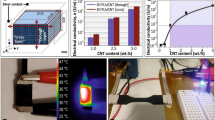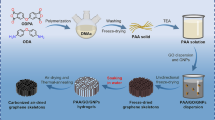Abstract
Electrically conductive exfoliated graphite nanoplatelet (GNP) / polylactic acid (PLA) nanocomposite films were fabricated using a two-step, scalable melt compounding process. The effect of the polymer’s physical properties, such as crystallinity, on the mechanical and electrical properties of the composites were determined. The crystallization characteristics of PLA were altered significantly by altering the cooling rate during compression molding of the films. The crystallinity and crystal structure were investigated using differential scanning calorimetry (DSC), wide angle X-ray diffraction (WAXD), and polarized optical microscopy (POM). The mechanical and electrical properties were also examined as a function of PLA’s crystallinity dictated by the cooling rate during compression molding. The electrical conductivity was examined using impedance spectroscopy. For the same GNP content, the crystallinity increases by ~40 % and electrical conductivity increases by ~3 orders of magnitude with decreased cooling rate indicating a strong correlation between polymer physical properties and electrical conductivity of the polymer composites. This mechanism can be utilized to tailor the electrical conductivity of a given filler/polymer system by tuning the physical properties of the polymer, without altering the fillers’ characteristics or the processing method, which is the common approach used.










Similar content being viewed by others
References
Jiang X, Drzal LT (2012) Multifunctional high-density polyethylene nanocomposites produced by incorporation of exfoliated graphene nanoplatelets 2: crystallization, thermal and electrical properties. Polym Compos 33:636–642
Wang Z, Liang ZY, Wang B, Zhang C, Kramer L (2004) Processing and property investigation of single-walled carbon nanotube (Swnt) buckypaper/epoxy resin matrix nanocomposites. Compos A Appl Sci Manuf 35:1225–1232
Murariu M, Dechief AL, Bonnaud L, Paint Y, Gallos A, Fontaine G, Bourbigot S, Dubois P (2010) The production and properties of polylactide composites filled with expanded graphite. Polym Degrad Stab 95:889–900
Kalaitzidou K, Fukushima H, Drzal LT (2007) Multifunctional polypropylene composites produced by incorporation of exfoliated graphite nanoplatelets. Carbon 45:1446–1452
Duan JK, Shao SX, Ya L, Wang LF, Jiang PK, Liu BP (2012) Polylactide/graphite nanosheets/Mwcnts nanocomposites with enhanced mechanical, thermal and electrical properties. Iran Polym J 21:109–120
Pinto AM, Cabral J, Tanaka DAP, Mendes AM, Magalhaes FD (2013) Effect of incorporation of graphene oxide and graphene nanoplatelets on mechanical and gas permeability properties of poly(lactic acid) films. Polym Int 62:33–40
Drumright RE, Gruber PR, Henton DE (2000) Polylactic acid technology. Adv Mater 12:1841–1846
Tait M, Pegoretti A, Dorigato A, Kalaitzidou K (2011) The effect of filler type and content and the manufacturing process on the performance of multifunctional carbon/poly-lactide composites. Carbon 49:4280–4290
Kim IH, Jeong YG (2010) Polylactide/exfoliated graphite nanocomposites with enhanced thermal stability, mechanical modulus, and electrical conductivity. J Polym Sci B Polym Phys 48:850–858
Gerhardt RA (2005) Impedance spectroscopy and mobility spectra. In: Bassani F, Liedl GL, Wyder P (eds) Encyclopedia of condensed matter physics. Elsevier, Oxford, pp 350–363
Ray SS, Yamada K, Okamoto M, Fujimoto Y, Ogami A, Ueda K (2003) New polylactide/layered silicate nanocomposites. 5. Designing of materials with desired properties. Polymer 44:6633–6646
Yasuniwa M, Tsubakihara S, Sugimoto Y, Nakafuku C (2004) Thermal analysis of the double-melting behavior of poly(L-lactic acid). J Polym Sci B Polym Phys 42:25–32
Chen XL, Kalish J, Hsu SL (2011) Structure evolution of alpha’-phase poly(lactic acid). J Polym Sci B Polym Phys 49:1446–1454
Hebert JS, Wood-Adams P, Heuzey MC, Dubois C, Brisson J (2013) Morphology of polylactic acid crystallized during annealing after uniaxial deformation. J Polym Sci B Polym Phys 51:430–440
Hoogsteen W, Postema AR, Pennings AJ, Tenbrinke G, Zugenmaier P (1990) Crystal-structure, conformation, and morphology of solution-spun poly(L-lactide) fibers. Macromolecules 23:634–642
Gopakumar TG, Page D (2004) Polypropylene/graphite nanocomposites by thermo-kinetic mixing. Polym Eng Sci 44:1162–1169
Pluta M, Galeski A (2002) Crystalline and supermolecular structure of polylactide in relation to the crystallization method. J Appl Polym Sci 86:1386–1395
Hirai N, Maeno Y, Tamura H, Kaneko D, Tanaka T, Ohki Y, Tajitsu Y, Kohtoh M, Okabe S, Ieee (2004) Dielectric properties of biodegradable polylactic acid and starch ester. Proceedings of the 2004 Ieee International Conference on Solid Dielectrics, vols. 1 and 2. New York, Ieee
Kalaitzidou K, Fukushima H, Askeland P, Drzal LT (2008) The nucleating effect of exfoliated graphite nanoplatelets and their influence on the crystal structure and electrical conductivity of polypropylene nanocomposites. J Mater Sci 43:2895–2907
Clingerman ML, Weber EH, King JA, Schulz KH (2003) Development of an additive equation for predicting the electrical conductivity of carbon-filled composites. J Appl Polym Sci 88:2280–2299
Lewis TJ (1990) Charge transport, charge injection and breakdown in polymeric insulators. J Phys D Appl Phys 23:1469–1478
Chodak I, Krupa I (1999) “Percolation effect” and mechanical behavior of carbon black filled polyethylene. J Mater Sci Lett 18:1457–1459
Diez-Pascual AM, Guan JW, Simard B, Gomez-Fatou MA (2012) Poly(phenylene sulphide) and poly(ether ether ketone) composites reinforced with single-walled carbon nanotube buckypaper: II—mechanical properties, electrical and thermal conductivity. Compos A Appl Sci Manuf 43:1007–1015
Acknowledgments
The authors would like to thank and acknowledge financial support provided by Cytec Engineered Materials and the Georgia Tech Manufacturing Institute.
Author information
Authors and Affiliations
Corresponding author
Rights and permissions
About this article
Cite this article
Sullivan, E.M., Oh, Y.J., Gerhardt, R.A. et al. Understanding the effect of polymer crystallinity on the electrical conductivity of exfoliated graphite nanoplatelet/polylactic acid composite films. J Polym Res 21, 563 (2014). https://doi.org/10.1007/s10965-014-0563-8
Received:
Accepted:
Published:
DOI: https://doi.org/10.1007/s10965-014-0563-8




